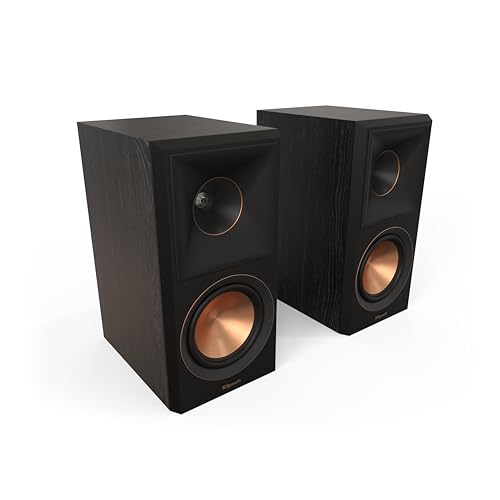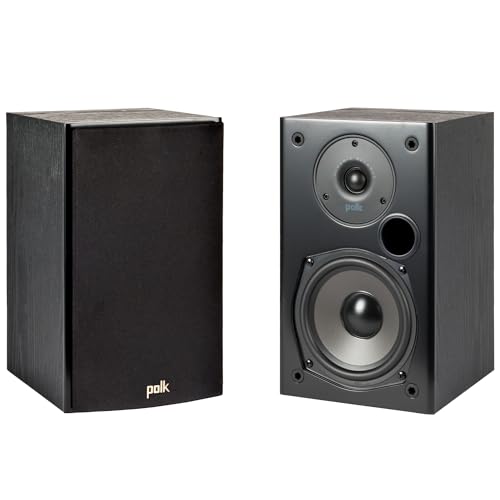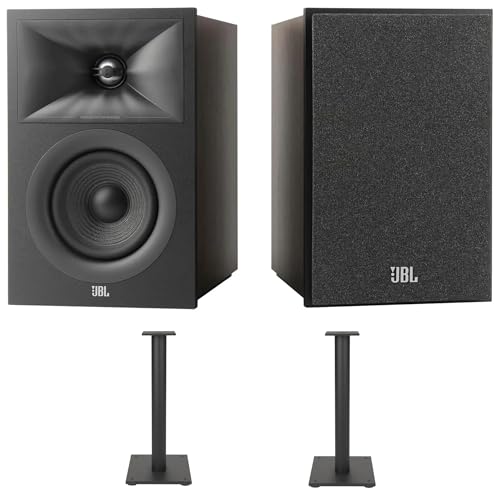There’s a moment every music lover and movie enthusiast chases: that feeling of being completely enveloped by sound. It’s the crisp snap of a snare drum, the subtle breath of a vocalist between lines, the thunderous roar of an engine that you don’t just hear, but feel in your chest. For years, I found myself on this quest, cycling through soundbars that promised cinematic experiences but delivered hollow echoes, and all-in-one systems that flattened the life out of my favorite albums. The problem was always a balance of space, complexity, and performance. I wanted the immersive, detailed audio of a high-end system, but I didn’t have the room—or the desire—for towering floor-standing speakers that dominate a living space. This is the classic audiophile’s dilemma: how to achieve expansive, dynamic sound from a compact, manageable footprint. Ignoring this challenge leads to a perpetual state of audio disappointment, where music and movies are merely heard, not experienced.
- BIGGER TRACTRIX HORN: A new, larger 90° x 90° silicone composite hybrid Tractrix horn provides crisper, clearer sound.
- LINEAR TRAVEL SUSPENSION (LTS) TITANIUM DIAPHRAGM TWEETER: The exclusive 1” LTS minimizes distortion for enhanced, detailed performance.
- VENTED TWEETER DESIGN: The vented tweeter housing enhances the detail in what you hear.
What to Consider Before Buying Bookshelf Speakers
A bookshelf speaker is more than just a compact audio device; it’s a key solution for achieving high-fidelity sound in spaces where larger speakers are impractical. They solve the problem of audio compromise, delivering a detailed stereo image, impressive dynamics, and a level of clarity that most single-unit solutions simply cannot match. Whether you’re building a dedicated two-channel music setup, upgrading the front channels of a home theater system, or creating a high-quality desktop audio rig, bookshelf speakers offer a potent combination of performance and versatility. Their main benefit lies in their ability to “disappear” acoustically, creating a soundstage that seems to extend far beyond the physical speakers themselves.
The ideal customer for this type of product is someone facing spatial constraints but unwilling to sacrifice audio quality. This includes apartment dwellers, office or bedroom audio enthusiasts, and home theater builders looking for powerful surround or front channels. They value clarity, detail, and the ability to build a modular system around an amplifier or AV receiver of their choice. Conversely, bookshelf speakers might not be suitable for those who desire the absolute deepest bass frequencies without a subwoofer, or for users who want a simple, plug-and-play solution with built-in amplification and streaming (who would be better served by powered or smart speakers). For those seeking the ultimate, room-shaking low-end for a massive home theater, larger floor-standing speakers might be a more direct, albeit more expensive and space-consuming, path.
Before investing, consider these crucial points in detail:
- Dimensions & Space: Bookshelf speakers, despite their name, often perform best on dedicated stands placed away from walls. Measure your available space, considering not just the speaker’s footprint (width and depth) but also the need for breathing room, especially for rear-ported designs. The Klipsch RP-500M II Bookshelf Speakers, for example, have a rear-firing Tractrix port, meaning they need a few inches of clearance from the back wall to prevent boomy, undefined bass.
- Performance & Sensitivity: Key metrics include frequency response, which tells you the range of sound the speaker can reproduce, and sensitivity (measured in dB). Higher sensitivity means the speaker can play louder with less power from an amplifier, making it easier to drive. The Klipsch line is famously efficient, making them an excellent match for a wide range of amplifiers, from low-power tube amps to high-current AV receivers.
- Materials & Durability: The materials used for the tweeter, woofer, and cabinet all dramatically impact the sound and longevity. Titanium tweeters, like those in the Klipsch, are known for their bright, detailed highs. Woofers made from materials like Klipsch’s Cerametallic are prized for being light yet rigid, enabling fast, tight bass response. The cabinet should be made of dense, non-resonant material like MDF to prevent unwanted vibrations from coloring the sound.
- Passive vs. Powered: The Klipsch RP-500M II Bookshelf Speakers are passive, meaning they require a separate, external amplifier or AV receiver to power them. This offers greater flexibility for system building and upgrading components over time. Powered speakers, by contrast, have amplifiers built-in, offering a simpler, all-in-one solution but with less modularity for future upgrades.
Keeping these factors in mind, the Klipsch RP-500M II Bookshelf Speakers stands out in several areas, particularly in its high sensitivity and proprietary driver technology. You can explore its detailed specifications here.
While the Klipsch RP-500M II Bookshelf Speakers is an excellent choice, it’s always wise to see how it stacks up against the competition. For a broader look at all the top models, we highly recommend checking out our complete, in-depth guide:
- 2 x AUX INPUT - Convenient connection to any device that has a 3.5mm headphone output or dual RCA output. Play from two devices via AUX at the same time, no plugging and switching needed
- EXPERIENCE AMAZING HOME THEATER SOUND WITH RICH, IMMERSIVE AUDIO – Featuring a 0.75" tweeter and a 5.25" Dynamic Balance driver, these passive bookshelf speakers deliver clear, balanced sound with...
- Each speaker in the Stage 2 series features Polycellulose ribbed cone woofers
First Impressions: Unboxing an Audio Icon
Opening the box containing the Klipsch RP-500M II Bookshelf Speakers is an event in itself. Klipsch understands presentation. The speakers are packed securely, and lifting them out, you’re immediately struck by their surprising heft. At 13 pounds each, they feel dense, solid, and exceptionally well-built. The furniture-grade ebony vinyl finish is immaculate, wrapping tightly around the MDF cabinet with no visible seams. It’s a classic, understated look that exudes quality.
Of course, the real visual drama happens when you remove the magnetically attached grilles. The signature spun-copper Cerametallic woofer is a stunning contrast against the black baffle, and the redesigned, larger 90° x 90° Tractrix horn looks more purposeful and integrated than ever. It’s a design that’s simultaneously aggressive and elegant. Setting them up on our stands, they make a powerful statement before a single note is even played. This second-generation model feels more refined than its predecessor, with subtle tweaks to the trim rings and a more seamless horn integration that elevates the overall aesthetic from merely good to genuinely premium.
What We Like
- Incredibly dynamic and lively sound that brings music and movies to life
- Exceptional clarity and detail in the high frequencies thanks to the Tractrix horn
- High sensitivity makes them easy to power with almost any amplifier or receiver
- Surprising bass output for their size, providing a full-bodied sound
- Premium build quality and iconic, statement-making aesthetics
Areas for Improvement
- The “V-shaped” sound signature with emphasized highs and lows may not suit listeners who prefer a neutral, flat response
- Can sound slightly bright or forward, potentially leading to listening fatigue for some users at high volumes
Deep Dive: Deconstructing the Klipsch Sound and Experience
After letting the speakers run in for about 40 hours to allow the drivers to settle, we put the Klipsch RP-500M II Bookshelf Speakers through their paces with a wide range of material. From the delicate vinyl crackle of a vintage jazz record to the explosive DTS-HD Master Audio track of a blockbuster film, our goal was to understand not just what these speakers do, but how they make you feel. Paired with a mid-range integrated amplifier, they immediately established their character: energetic, detailed, and utterly engaging.
Sonic Signature: The Tractrix Horn and Titanium Tweeter in Action
The heart and soul of the Klipsch sound has always been its horn-loaded tweeter, and the updated version in the RP-500M II is a masterpiece of engineering. The larger 90° x 90° silicone composite hybrid Tractrix horn isn’t just a marketing term; it’s a precisely shaped waveguide that controls the dispersion of high-frequency sound. In practice, this does two things magnificently. First, it focuses the sound energy towards the listening position, reducing reflections from walls and ceilings. The result is a startlingly clear and detailed soundstage. When listening to Fleetwood Mac’s “Rumours,” the intricate cymbal work on “Go Your Own Way” was rendered with a crispness and texture that lesser speakers often smear into a generic shimmer. Each tap and decay was distinct and airy.
Second, the horn dramatically increases the efficiency of the 1” Linear Travel Suspension (LTS) Titanium Diaphragm Tweeter. This means the tweeter barely has to move to produce high volumes, which drastically reduces distortion. Vocals, in particular, benefit from this. On tracks like Adele’s “Hello,” her powerful voice soared without a hint of strain or harshness, retaining its rich emotional weight even at concert-like levels. This detail retrieval is something many users immediately notice. As one reviewer aptly put it after upgrading, “they sound great, way more detailed than what I had before.” This is the Klipsch magic: it digs into the recording and presents you with information you may have never noticed, creating a more intimate and exciting connection to the artist. The vented tweeter housing further refines this, preventing standing waves from building up behind the diaphragm and ensuring the top-end remains clean and articulate.
Low-End Authority: The Cerametallic Woofer and Tractrix Port
A great speaker needs to be more than just treble detail; it requires a solid foundation. The 5.25” copper-spun Cerametallic woofer in the Klipsch RP-500M II Bookshelf Speakers is engineered for exactly that. The Cerametallic material is a combination of ceramic and aluminum, creating a cone that is incredibly light but also extremely rigid. This rigidity prevents the cone from flexing or “breaking up” during intense, low-frequency passages, resulting in bass that is tight, fast, and remarkably punchy for a speaker of this size. On bass-heavy tracks like Daft Punk’s “Get Lucky,” the iconic bassline was taut and melodic, with each note clearly defined rather than becoming a monotonous boom.
This woofer works in tandem with the rear-firing Tractrix port. Unlike simple circular ports, Klipsch’s design uses proprietary geometry to move air more efficiently and with less turbulence, or “chuffing.” The effect is a cleaner, more powerful bass response that belies the speaker’s compact dimensions. We found, as one user did, that in a medium-sized room, these speakers “definitely held their own” even without the aid of a subwoofer. However, placement is key. Pushing them right up against a wall will over-excite the bass, making it sound bloated. We found the sweet spot to be around 8-12 inches from the rear wall, which allowed the bass to breathe and integrate seamlessly with the midrange. For desktop use, as another listener discovered, room acoustics play a huge role, and pairing them with a small, fast subwoofer can fill in those final lowest octaves for a truly full-range experience. If you’re looking for a speaker that delivers a thrilling, full-bodied sound without demanding a subwoofer from day one, the performance of these woofers is a compelling reason to consider them.
Design, Build, and Real-World Setup
Beyond the sound, the user experience of the Klipsch RP-500M II Bookshelf Speakers is overwhelmingly positive. The physical construction is top-notch. The MDF cabinet feels inert; rapping a knuckle against the side produces a dull, solid thud, indicating excellent bracing and a lack of resonance that could color the sound. The magnetic grilles are a simple but brilliant touch, allowing for a quick transition between a stealthy, understated look and the bold, high-tech “grilles-off” appearance without fumbling with fragile pins.
Setting them up is straightforward for anyone familiar with passive speakers. The binding posts are high quality, accepting banana plugs, spades, or bare wire. However, as one user astutely pointed out, their placement at the very bottom of the speaker’s rear panel can be slightly awkward, especially if you have thick, stiff speaker cables. It’s a minor ergonomic quirk worth noting. The same user mentioned the danger of unscrewing the connectors too far and dropping a piece inside the port—a valid warning that speaks to the real-world experience of setup. Once connected, their high efficiency makes amplifier pairing a breeze. We drove them effortlessly with a 50-watt-per-channel integrated amp, and they had plenty of headroom, suggesting they would be just as happy with a quality AV receiver or even a lower-powered Class D desktop amp. This versatility makes them a fantastic building block for a system that can grow with you over time.
What Other Users Are Saying
Our findings align closely with the broader consensus from other enthusiasts. The overwhelming majority of feedback is positive, centering on the speakers’ dynamic and engaging character. One user, replacing a pair of well-regarded ELAC speakers, simply stated, “Love these speakers,” noting their ability to perform admirably even in a secondary zone without subwoofer support. This speaks volumes about their full-range capability for their size. Another user who built a desktop system around them highlighted a critical point we also observed: “the important thing about these kind of speakers is knowing your room acoustics and where you place them.” This is expert-level advice; the performance of any good speaker is intrinsically linked to its environment.
On the critical side, the feedback is less about flaws and more about character. A common observation, framed by one reviewer as a potential issue for some, is the “V-shaped” sound profile—meaning slightly boosted bass and treble relative to the midrange. They correctly note this isn’t for someone seeking a “completely neutral sound,” but is perfect for those who, like us, prefer a more “vibrant” presentation. The only outright negative comment we found concerned a minor cosmetic issue with a crooked logo, a rare quality control slip that is unfortunate but doesn’t impact the stellar audio performance.
How Does the Klipsch RP-500M II Bookshelf Speakers Compare to the Alternatives?
The Klipsch RP-500M II Bookshelf Speakers exist in a competitive market, and while they excel in delivering an exciting, high-efficiency sound, different listeners may have different priorities. Here’s how they stack up against three notable competitors.
1. Edifier R2000DB Bluetooth Bookshelf Speakers
The Edifier R2000DB represents a fundamentally different approach. These are powered speakers, meaning the amplifier is built-in, and they also include Bluetooth connectivity and an optical input. This makes them a fantastic all-in-one solution for someone who wants great sound without the complexity and cost of separate components. If your goal is a simple, clean setup for a computer, TV, or for streaming music directly from your phone, the Edifiers are a compelling choice. However, you sacrifice the ability to upgrade your amplifier or DAC down the line. The Klipsch speakers are for the system-builder who values modularity and wants to tailor the sound with their choice of electronics, offering a higher performance ceiling in the long run.
2. Micca OoO Slim Bookshelf Speakers
The Micca OoO’s primary selling point is its ultra-slim design. At under 4 inches wide, these speakers are designed for environments where even a traditional bookshelf speaker is too bulky. They are an ideal choice for wall-mounting as surround speakers in a home theater, or for flanking a monitor on a very crowded desk. Their unique driver array with three-inch woofers is clever, but physics dictates a trade-off. They cannot produce the same depth of bass or achieve the same scale and dynamic impact as the much larger Klipsch RP-500M II. The Micca OoO is the perfect pick for the user whose top priority is discreet placement and space-saving, whereas the Klipsch is for the user prioritizing sonic performance and impact.
3. Micca RB42 Bookshelf Speaker Pair
The Micca RB42 is a legend in the budget audiophile world, known for delivering a remarkably balanced and neutral sound for its price. This makes it a direct philosophical competitor to the Klipsch. Where the Klipsch is energetic, bright, and forward (the “V-shape”), the Micca RB42 is warmer, smoother, and more laid-back. It provides a very accurate, non-fatiguing sound that may appeal more to purists or those listening to genres like classical or folk. However, it is significantly less efficient than the Klipsch and requires a reasonably powerful amplifier to come alive. The RB42 is the choice for the listener on a budget who prioritizes tonal neutrality above all else, while the Klipsch RP-500M II is for the listener who wants their music to be a thrilling, dynamic, and high-impact experience.
Our Final Verdict: A Dynamic Masterclass in a Compact Form
After extensive listening, testing, and comparison, our conclusion is clear: the Klipsch RP-500M II Bookshelf Speakers are a phenomenal achievement. They deliver on the Klipsch promise of dynamic, live-sounding audio with a level of detail and clarity that is deeply impressive in this category. They are the perfect speaker for someone who wants to feel the energy of their music and the impact of their movies. Their high efficiency makes them incredibly versatile for system pairing, and their iconic design and superb build quality make them a product you’ll be proud to display.
While their forward, exciting sound signature may not be for the listener who craves absolute neutrality, for anyone else, they offer an experience that is anything but boring. They transform listening from a passive background activity into an active, engaging event. If you’re building a home theater, a two-channel stereo, or a high-end desktop system and you want speakers that excite the senses and draw you deep into the performance, the Klipsch RP-500M II Bookshelf Speakers are an enthusiastic and confident recommendation.
If you’ve decided the Klipsch RP-500M II Bookshelf Speakers is the right fit for your audio journey, you can check its current price and purchase it here.
Last update on 2025-10-23 / Affiliate links / Images from Amazon Product Advertising API




